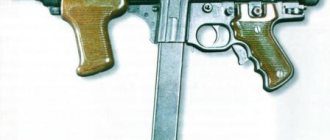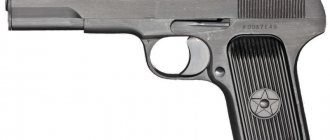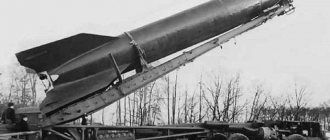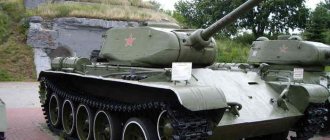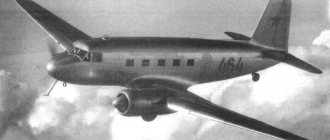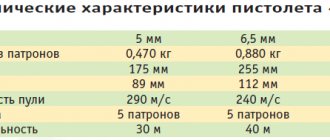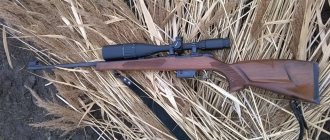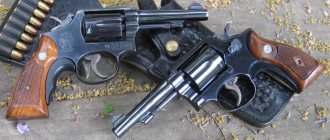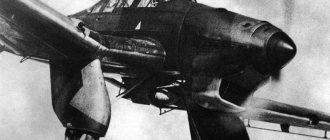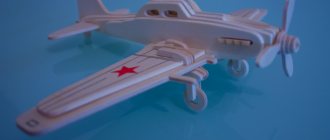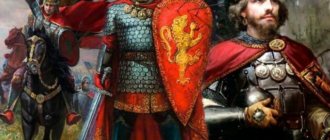The famous Buffalo aircraft was developed in response to a US request for a new carrier-based fighter to replace the Grumman F3F. A characteristic feature of the all-metal monoplane with retractable landing gear was a relatively short fuselage with a large cross-section - like the Soviet I-16 or the American P-35. The project was developed under the leadership of D. Brown based on the experience gained during the creation of the XSBA-1 deck-based reconnaissance dive bomber.
The armament consisted of a standard set for American fighters - 1 12.7-mm and 1 7.62-mm synchronized machine gun, but it was possible to install 2 more 12.7-mm machine guns in the wing. On the XF2A-1 prototype, which first flew in air on December 2, 1939, a 9-cylinder air-cooled Wright R-1820-22 engine (950 hp) was installed.
The tests were difficult - the engine lacked power, and accordingly, the flight data turned out to be worse than expected. A number of changes were made to the design of the aircraft - in particular, the hood was redesigned and the cockpit canopy was redesigned. Flight performance improved slightly, but the XF2A-1 won the competition, mainly due to the fact that its competitor, the Grumman XF4F-2, crashed. In June 1938, the US Navy ordered 55 production aircraft, with deliveries beginning in May 1939.
A total of 509 aircraft were produced, including the prototype. The vast majority of Buffaloes were exported and used from land airfields.
The history of the creation of the F2A (B-239) Buffalo fighter
In 1935, Grumman, among others, participated in the US Navy competition to create a carrier-based fighter. Having reached the finals, Grumman (with the modernized F3F biplane) ultimately lost to Brewster, who presented the XF2A compact monoplane project, created under the leadership of L. Brown. The XF2A was not only more technologically advanced than its competitor, but also cheaper to produce.
At the end of 1935, Brewster received an order to produce a prototype.
The prototype XF2A-1 carrier-based fighter made its first flight on December 2, 1937. After flight tests, the aircraft (the first in US history) was blown in the NASA wind tunnel at Langley Field, received its share of comments and went for revision. However, within a year the designers dealt with all the comments, the aircraft passed all checks and on June 11, 1938 it was put into mass production on Long Island, under the designation F2A . A little later, the plane received its own name - buffalo (“buffalo”).
Drawing of the F2A Buffalo fighter (B-239)
A relatively inexpensive and unpretentious fighter, originally designed as a carrier-based aircraft for the US Navy, the F2A unexpectedly turned out to be in great demand for export - Finland, Belgium, Great Britain, Canada, as well as Australia and New Zealand expressed interest in purchasing the new product (though mainly in a purely land modification) ( Poland planned purchases, but due to the outbreak of war, the contract was canceled).
Production of the F2A Buffalo continued until September 1941, with a total of 507 aircraft of all modifications produced.
In combat conditions, the F2A "Buffalo" was used since 1940 (Finnish models under the designation B-239) in the Soviet-Finnish War; English and Dutch pilots used it in the battles for Malaya, Burma and Indonesia in 1941-1942. American (carborne) F2A-3s were used by the Americans in the Battle of Midway Island, and requisitioned Finnish B-339s were used in New Guinea in 1942.
Carrier-based fighter F2A "Buffalo" (B-239)
Since the end of 1942, the F2A "Buffalo" fighters in the US Navy were put into reserve and were used only as training aircraft. The only exception was a few F2A-2 “bulls” in the Panama Canal air defense group and also served until 1945. In Great Britain and New Zealand, the Buffalo were withdrawn from service in May 1942, in Australia in January 1944. In Finland, the former “deck soldiers” were seriously delayed and not only went through the entire war, but also served even after it. The last F2A/B-239 was decommissioned from the country's air force only in 1948.
An excerpt characterizing the Brewster F2A Buffalo
All Rostov's cards were broken, and up to 800 tons of rubles were written on him. He was about to write 800 thousand rubles on one card, but while he was being served champagne, he changed his mind and wrote the usual jackpot again, twenty rubles. “Leave it,” said Dolokhov, although he did not seem to look at Rostov, “you’ll get even sooner.” I give to others, but I beat you. Or are you afraid of me? - he repeated. Rostov obeyed, left the written 800 and placed the seven of hearts with a torn off corner, which he picked up from the ground. He remembered her well afterwards. He placed the seven of hearts, writing 800 above it with a broken piece of chalk, in round, straight numbers; drank the served glass of warmed champagne, smiled at Dolokhov’s words, and with bated breath, waiting for the seven, began to look at Dolokhov’s hands holding the deck. Winning or losing this seven of hearts meant a lot for Rostov. On Sunday last week, Count Ilya Andreich gave his son 2,000 rubles, and he, who never liked to talk about financial difficulties, told him that this money was the last one until May, and that is why he asked his son to be more economical this time. Nikolai said that this was too much for him, and that he gave his word of honor not to take any more money until spring. Now 1,200 rubles of this money remained. Therefore, the seven of hearts meant not only a loss of 1,600 rubles, but also the need to change this word. With a sinking heart, he looked at Dolokhov’s hands and thought: “Well, quickly, give me this card, and I’ll take my cap, go home to dinner with Denisov, Natasha and Sonya, and I’ll certainly never have a card in my hands.” At that moment, his home life, jokes with Petya, conversations with Sonya, duets with Natasha, a picket with his father, and even a calm bed in the Cook's house, presented themselves to him with such strength, clarity and charm, as if all this were long past, lost and priceless happiness. He could not allow that a stupid accident, forcing the seven to lie first on the right than on the left, could deprive him of all this newly understood, newly illuminated happiness and plunge him into the abyss of an as yet unexperienced and uncertain misfortune. This could not be, but he still waited with bated breath for the movement of Dolokhov’s hands. These broad-boned, reddish hands with hair visible from under the shirt, put down a deck of cards, and took hold of the glass and pipe being served. - So you're not afraid to play with me? - Dolokhov repeated, and, as if in order to tell a funny story, he put down the cards, leaned back in his chair and slowly began to tell with a smile: - Yes, gentlemen, I was told that there was a rumor in Moscow that I was a card sharper, so I advise you to be careful with me. - Well, swords! - said Rostov. - Oh, Moscow aunties! - said Dolokhov and took up the cards with a smile. - Aaah! – Rostov almost shouted, raising both hands to his hair. The seven he needed was already at the top, the first card in the deck. He lost more than he could pay. “However, don’t get too carried away,” said Dolokhov, glancing briefly at Rostov and continuing to throw. After an hour and a half, most of the players were already jokingly looking at their own game. The whole game focused on Rostov alone. Instead of one thousand six hundred rubles, a long column of numbers was written down behind him, which he had counted up to the tenth thousand, but which now, as he vaguely assumed, had already risen to fifteen thousand. In fact, the entry already exceeded twenty thousand rubles. Dolokhov no longer listened or told stories; he followed every movement of Rostov’s hands and occasionally glanced briefly at his note behind him. He decided to continue the game until this entry increased to forty-three thousand. He chose this number because forty-three was the sum of his years added up with Sonya's years. Rostov, leaning his head on both hands, sat in front of a table covered with writings, covered in wine, and littered with cards. One painful impression did not leave him: these broad-boned, reddish hands with hair visible from under his shirt, these hands that he loved and hated, held him in their power. “Six hundred rubles, ace, corner, nine... it’s impossible to win back!... And how fun it would be at home... Jack on n... it can’t be!... And why is he doing this to me?...” Rostov thought and recalled. Sometimes he would play a big card; but Dolokhov refused to beat her, and he himself nominated the jackpot. Nicholas submitted to him, and then prayed to God, as he prayed on the battlefield on the Amsteten Bridge; then he wished that the card that would be the first to fall into his hand from a pile of curved cards under the table would save him; either he calculated how many laces there were on his jacket and with the same number of points he tried to bet a card on the entire loss, then he looked around at the other players for help, then he peered into Dolokhov’s now cold face and tried to understand what was going on inside him. “After all, he knows what this loss means to me. He can't want my death, can he? After all, he was my friend. After all, I loved him... But it’s not his fault either; What should he do when he is lucky? And it’s not my fault, he told himself. I didn't do anything wrong. Have I killed anyone, insulted anyone, or wished harm? Why such a terrible misfortune? And when did it start? Just recently I approached this table with the thought of winning a hundred rubles, buying my mother this box for her name day and going home. I was so happy, so free, cheerful! And I didn’t understand then how happy I was! When did this end, and when did this new, terrible state begin? What marked this change? I still sat in this place, at this table, and still chose and pushed out cards, and looked at these big-boned, dexterous hands. When did this happen, and what happened? I am healthy, strong and still the same, and still in the same place. No, it can't be! It’s true that all this will not end in anything.”
Design of the F2A (B-239) Buffalo fighter
The F2A "Buffalo" fighter was an all-metal (with the exception of the fabric covering of the control surfaces) mid-wing cantilever structure.
The aircraft's wing is single-spar, with a NASA-230 profile. The landing gear is tricycle, retractable (wheels in the fuselage, struts in the wing), with a tail wheel (non-retractable on export versions). The fuselage has an oval cross-section, semi-monocoque type, with working skin.
The power plant consisted of a Wright Cyclone R-1820 piston 9-cylinder air-cooled radial engine with a Hamilton Standard Hydromatic or Curtiss Electric three-bladed variable-pitch propeller.
The pilot's cabin had a sliding, multi-bound canopy and had no floor; the seat was attached to an armored frame. In aircraft operating over the sea, a container with an inflatable boat was attached behind the armored back.
Internal structure of the F2A Buffalo fighter (B-239)
Modifications of F2A (B-239) "Buffalo"
- XF2A-1 (aka B-139) - prototype with XR-1820-G1 engine (850 hp). First flight December 2, 1937.
- XF2A-2 - prototype with R-1820-G40 engine. Manufactured in early 1939.
- F2A-1 - the first production version with the R-1820-34 engine. The armament consisted of 4x 12.7 mm machine guns. In June-October 1938, 11 aircraft were manufactured.
- F2A-2 - modernized, with an R-1820-G40 engine, modified vertical tail, additional fuel tanks and bomb racks. In 1939, 43 aircraft were manufactured.
- The F2A-3 is a carrier-based fighter with a long nose and an R-1820-G205 engine. It had enlarged fuel tanks, a modified cockpit canopy, and enhanced armor protection. In January-November 1941, 107 aircraft were manufactured.
- B-239 is an export version of the F2A-1 for Finland with an R-1820-G5 engine (950 hp). It was distinguished by the absence of deck equipment and lower cabin glazing. The armament consisted of 13.2 mm German Spandau machine guns. In June-October 1938, 44 aircraft were manufactured. Disassembled, they were delivered to Sweden, where they were assembled at SAAB.
Carrier-based fighter F2A-3, one of the latest releases
- The B-339B is an export version of the F2A-2 for Belgium. It was distinguished by the absence of ventral windows and deck equipment. In 1939, 40 aircraft were manufactured. After the surrender of Belgium, 38 of them were redirected to Great Britain.
- B-339D - export for the Dutch West Indies, with simplified equipment, a fixed tail wheel and a telescopic sight. In 1940, 72 aircraft were manufactured.
- B-339E (“Buffalo” Mk.I) - export to Great Britain, with R-1820-G105A engine (1200 hp), Hamilton Standard Hydromatic propeller, pilot's seat with armored backrest, ST-1 red dot sight, reinforced chassis. 170 aircraft were manufactured.
- The B-429 is an export version of the F2A-3 for the Dutch West Indies. It featured an R-1820-G105A/G205A engine and simplified on-board equipment. The armament consisted of 6x 7.69 mm machine guns. In 1941, 20 aircraft were manufactured.
- "Humu" is a Finnish version of the B-239 with a wooden wing after the supply of spare parts for the original aircraft from the United States ceased. Designed by . Made in 1 copy.
Links
Carrier-based fighters FR Fireball · F2A Buffalo · F4F Wildcat · F6F Hellcat · F8F Bearcat · F4U Corsair Night fighters P-61 Black Widow P-70 Nighthawk F7F Tigercat Strategic bombers B-17 Flying Fortress · B-24 Liberator · B-29 Superfortress · B-32 Dominator Tactical bombers B-10 B-18 Bolo PV Ventura B-23 Dragon A-22 Maryland A-30 Baltimore B-25 Mitchell B-26 Marauder Carrier bombers SBN SB2U Vindicator SB2A Buccaneer SBD Dauntless SB2C Helldiver TBD Devastator TBF Avenger A-1 Skyraider² XVTS-2 Stormtroopers A-20 Havoc A-26 Invader A-31 Vengeance A-36 Apache (Invader) SBC Helldiver Scouts O-52 Owl Float planes SOC Seagull SO3C Seamew SC Seahawk J2F Duck N-3PB OS2U Kingfisher flying boats Dolphin · Goose · Widgeon · S-43 · PBY Catalina · PB2Y Coronado · PBM Mariner Transport aircraft and gliders C-46 Commando · C-47 Skytrain · C-54 Skymaster · C-60 Lodestar · C-75 Stratoliner · C-87 Liberator Express · C-108 Flying Fortress · CG-13 · CG-15 · CG-3 · CG -4 · XCG-14 · Boeing XB-15 Training aircraft L-3 Grasshopper · T-6 Texan · AT-12 Guardsman · AT-17 Bobcat · J-3 Cub · BT-13 Valiant · SNC-1 Experimental and prototypes BTD FM-1 F8B SB2D TB2D XA-32 XF5F XF5U XP-46 XFG-1 XP-49 XP-50 XP-52 XP-54 XP-55 XP -56 · XP-57 · XP-58 · XP-62 · XP-67 · XP-69 · XP-71 · XP-72 · P-75 · XP-76 · XP-77 · XP-79 · XP-81 · XP-83 · XA-41 · · XB-19 · XB-28 · YB-35 · XB-38 · XB-39 · YB-40 · XB-41 · XB-42 · XB-43 · XB-46 · XB-48 · XBTC · XBTK · XPB2M · XPBB · XTSF · TBY Notes : ¹ ² - were developed and tested during the Second World War, adopted for service after its end;
Characteristics of the B-239 Buffalo
A country:USAType:FighterYear of issue:1937Crew:1 personEngine:1x R-1820-G5, 950 hpMaximum speed:487 km/hPractical ceiling:9900 mRange of flight:1745 kmEmpty weight:2146 kgMaximum take-off weight:3247 kg (normal takeoff)Wingspan:10.67 mLength:7.83 mHeight:3.66 mWing area:19.4 mWeapons:4x 13.2 mm machine guns
Characteristics are given for the B-239 fighter
Source: compilation based on publicly available information on the Internet, as well as the book Carrier-Based Fighters of the Second World War. - Kudishin I.V., M.: AST, Astrel, 2001.
Literature
- Kondratyev V.
Lost confidence in “Buffalo” (Russian) // Wings of the Motherland. - M., 1992. - No. 4. - P. 8-12. — ISSN [www.sigla.ru/table.jsp?f=8&t=3&v0=0130-2701&f=1003&t=1&v1=&f=4&t=2&v2=&f=21&t=3&v3=&f=1016&t=3&v4=&f=1016&t=3&v5 =&bf=4&b=&d=0&ys=&ye=&lng=&ft=&mt=&dt=&vol=&pt=&iss=&ps=&pe=&tr=&tro=&cc=UNION&i=1&v=tagged&s=0&ss=0&st=0&i18n=ru&rlf=&psz =20&bs=20&ce=hJfuypee8JzzufeGmImYYIpZKRJeeOeeWGJIZRrRRrdmtdeee88NJJJJpeeefTJ3peKJJ3UWWPtzzzzzzzzzzzzzzzzbzzvzzpy5zzjzzzzzzzzzzzzzzzzzzzzzzzzz zzzzztzzzzzzzbzzzzzzzzzzzzzzzzzzzzzzzzzzzzzzzzzyeyTjkDnyHzTuueKZePz9decyzzLzzzL*.c8.NzrGJJvufeeeeeJheeyzjeeeeJh*peeeeKJJJJJJJJJmjHvOJJJJJJJJfe eeieeeeSJJJJSJJJ3TeIJJJJ3..E.UEAcyhxD.eeeeeeuzzzLJJJJ5.e8JJJheeeeeeeeeeeeyeyeK3JJJJJJJJ*s7defeeeeeeeeeeeeeeeeeeeeeeeeSJJJJJJJZIJJzzz1..6LJJJJJJtJJZ4….EK*&deb ug=false 0130-2701].
